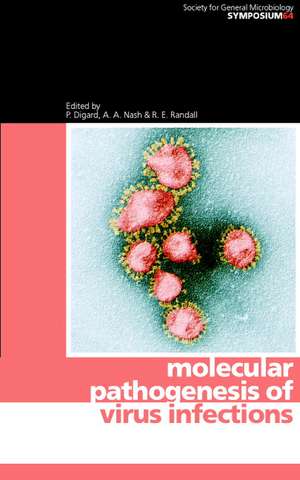Molecular Pathogenesis of Virus Infections: Society for General Microbiology Symposia, cartea 64
Editat de P. Digard, A. A. Nash, R. E. Randallen Limba Engleză Hardback – 20 apr 2005
Preț: 457.53 lei
Preț vechi: 547.02 lei
-16% Nou
Puncte Express: 686
Preț estimativ în valută:
87.58€ • 95.16$ • 73.61£
87.58€ • 95.16$ • 73.61£
Carte indisponibilă temporar
Doresc să fiu notificat când acest titlu va fi disponibil:
Se trimite...
Preluare comenzi: 021 569.72.76
Specificații
ISBN-13: 9780521832489
ISBN-10: 0521832489
Pagini: 358
Ilustrații: 30 b/w illus. 9 colour illus. 7 tables
Dimensiuni: 157 x 234 x 22 mm
Greutate: 0.64 kg
Ediția:New.
Editura: Cambridge University Press
Colecția Cambridge University Press
Seria Society for General Microbiology Symposia
Locul publicării:Cambridge, United Kingdom
ISBN-10: 0521832489
Pagini: 358
Ilustrații: 30 b/w illus. 9 colour illus. 7 tables
Dimensiuni: 157 x 234 x 22 mm
Greutate: 0.64 kg
Ediția:New.
Editura: Cambridge University Press
Colecția Cambridge University Press
Seria Society for General Microbiology Symposia
Locul publicării:Cambridge, United Kingdom
Cuprins
Preface; 1. Adaptive immune responses J. L. Whitton; 2. T-cell responses and dengue haemorrhagic fever G. Screaton and J. Mongkolsapaya; 3. The immune response to human immunodeficiency virus type 1 (HIV-1) E. Turnbull and P. Borrow; 4. Persistent RNA virus infections C. M. Dixon, L. Breakwell, G. Barry and J. K. Fazakerley; 5. Exotic virus pathogenesis S. Nichol; 6. Molecular approaches to the pathogenesis of feline coronaviruses C. Dye and S. Siddell; 7. The transmissible spongiform encephalopathies J. C. Manson and R. M. Barron; 8. Influenza virus pathogenicity R. G. Webster, A. S. Lipatov and E. Hoffmann; 9. RNAi as an antiviral mechanism and therapeutic approach R. P. van Rij and R. Andino; 10. Neurons and host immunity conspire to maintain herpes simplex virus in a latent state M. L. Freeman, V. Decman and R. L. Hendricks; 11. Hepatitis C virus disruption of interferon signalling pathways and evasion of innate intracellular antiviral defences S. M. Lemon and K. Li; 12. Human papillomaviruses and their effects on cell cycle control and apoptosis L. Gray, C. Jolly and C. S. Herrington; 13. Intracellular antiviral defence mechanisms: the power of interferon-regulated restriction factors O. Haller, F. Weber and G. Kochs; 14. Poxvirus immune evasion A. Alcami; 15. Evasion of host defence systems by African swine fever virus L. K. Dixon; 16. Murid herpesvirus 4 as a model for gammaherpesvirus pathogenesis J. P. Stewart, D. Hughes, L. Roaden and B. Ebrahimi; Index.
Descriere
Covers the central factors that influence the pathogenicity of virus and prion infections.









